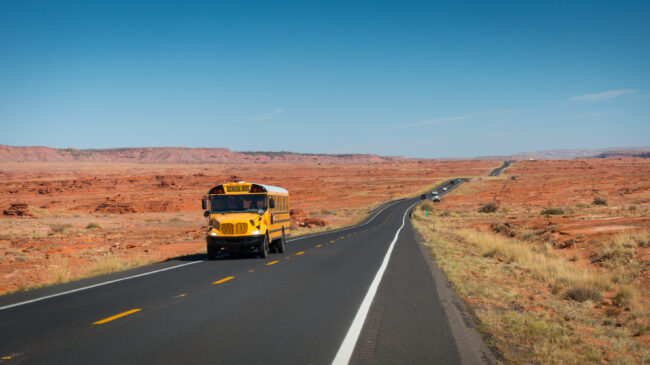Arizona has been a pioneer in advancing policy reforms to encourage high-quality education choices. This includes giving families options for open enrollment at traditional public schools, establishing hundreds of charter schools, offering education savings accounts, and providing tuition aid for private education to those who qualify. Unfortunately, having a choice of where your student will go to school to learn is not helpful if you cannot get him or her to the school.
Wealthier parents can typically afford to arrange for their children to get to and from the school that best meets their individual needs. But many low-income and working-class families are not able to transport their children to some of the better schools that they would prefer to send them to. Thus, despite Arizona’s school choice laws, limited transportation options mean many kids still have to attend neighborhood schools that may not be a good fit for them.
Currently, some of Arizona’s highest-quality schools are unable to offer student transportation thanks to well-meaning but antiquated state transportation laws. Fortunately, the need for modernizing school transportation is finally getting the attention it deserves and meaningful reform is on the horizon.
Many of Arizona’s public schools cannot meet the geographic diversity of their students’ transportation needs through traditional 60-foot yellow school buses. These buses are expensive to acquire, operate, and maintain, and require a driver with a commercial driver’s license. Further, this single mode of transportation doesn’t allow for schools to provide transportation to high-need pockets of students that can better access their schools via a smaller vehicle. Smaller, lower-cost vehicles would help students living in rural, geographically diverse areas of the state, but also assist urban families who have the opportunity to attend a school that is miles across town.
This growing public transportation problem has been further exacerbated during the COVID-19 pandemic, as some existing bus drivers have sought higher pay they can get by using their commercial driver’s licenses in the trucking industry, leading to school bus driver shortages and cancellations of existing routes.
But new legislation in the State Senate could bring more flexibility to school transportation and allow more Arizona families to access the schools that meet their particular needs.
Arizona recently established a $20 million Transportation Modernization Grants Program to reimagine how Arizona provides transportation to its K-12 students. Throughout the legislative process, a diverse pool of applicants detailed the barriers they faced transporting their children to school. Many of those concerns were connected to the types of vehicles that can legally transport students. Dozens of schools have requested that the state looks at alternative vehicles for picking up students.
As a result of the feedback gained during the public comment period, State Senator Sine Kerr introduced Senate Bill 1630 to address these challenges. The bill contains several important reforms.
First, SB 1630 would provide Arizona’s schools the ability to transport students to and from school in 11-to-15 passenger vehicles. In non-education contexts, mass transit agencies have successfully operated 11-to-15 passenger vehicles for over a generation. These vehicles provide a more tailored, environmentally-friendly transportation solution that works especially well in suburban and rural areas. The route mileage generated by these vehicles would also be included in the state’s transportation funding formula so as not to disadvantage school districts that look beyond the yellow bus.
Second, the legislation would reform the School Bus Advisory Council and rename it the Student Transportation Advisory Council. The changes would add charter representation to the council, allow it to consider cooperative purchase agreements on different vehicles, and encourage the council to think beyond the yellow bus in school transportation.
Third, the bill would increase the distance that schools can transport students outside their school districts from 20 miles to 30 miles. In metro Phoenix, for example, the bill’s 10-mile increase could double the number of students that schools can transport and allow far more working-class families to choose and access schools that better suit their particular needs.
Just as importantly, the bill requires the Department of Public Safety to promulgate new regulations on the use of these vehicles in school transportation and require that operators of these vehicles meet the same safety training requirements of school bus drivers, minus the commercial driver’s license for heavy-duty vehicles like buses and semi-trucks. This would allow the department to have oversight of all school transportation vehicles and assess any vehicle type before it can transport students, which should help address concerns parents may have regarding safety.
While Senate Bill 1630 would not solve all of Arizona’s school transportation problems and limitations, expanding vehicle choice for schools and increasing how far these drivers can go to pick up students is a first step to help ensure high-quality schools are accessible to all students, regardless of where they happen to live.
The outdated one-size-fits-all approach to school transportation shouldn’t continue to stand between families and educational opportunities.


